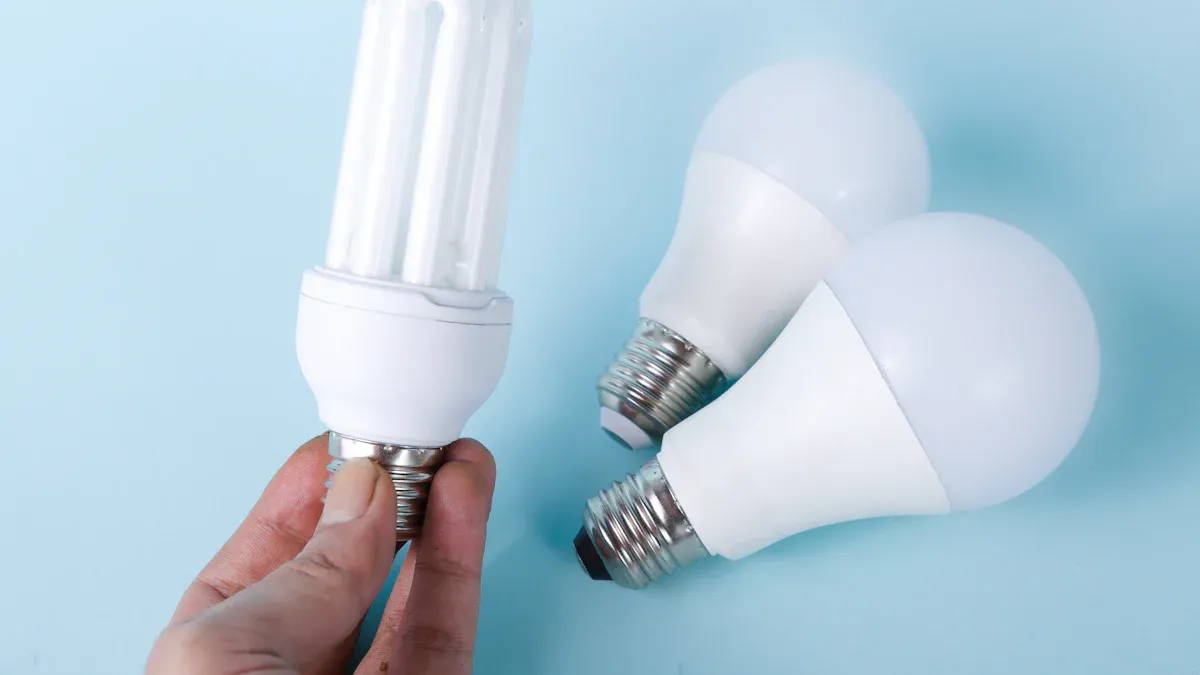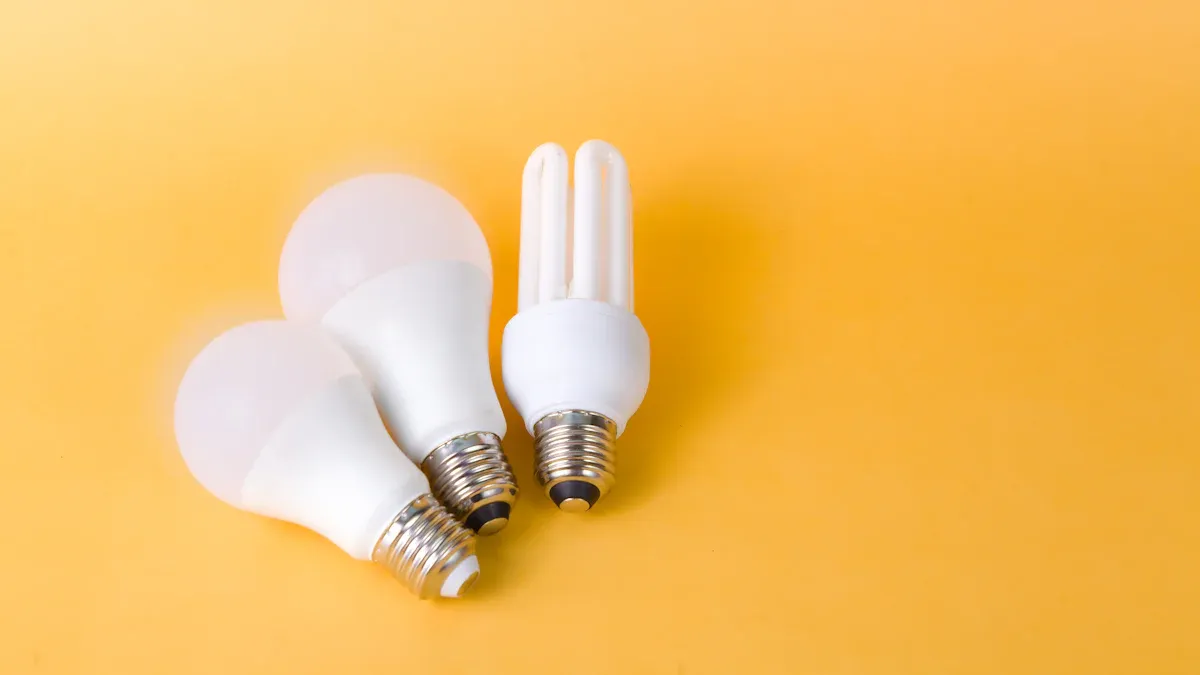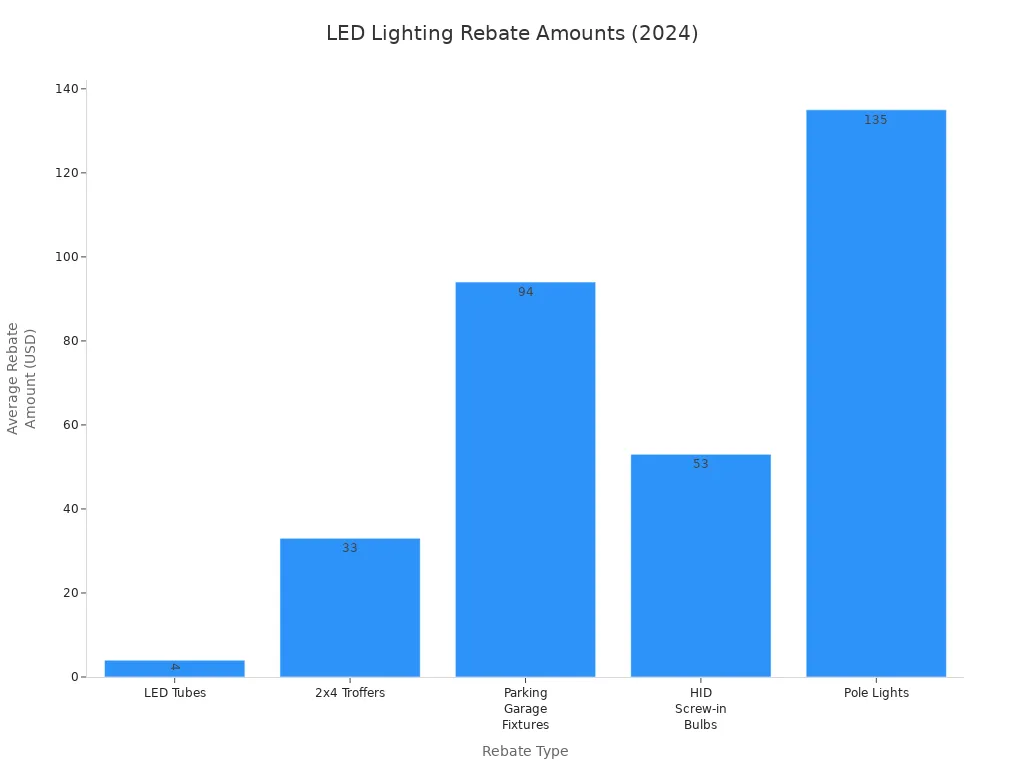7 Key Benefits of LED Lamps for Home and Business Lighting

You want brighter spaces and lower bills, right? LED lighting gives you that and more. The key benefits make a real difference for both home and business. LED lamps last longer than old bulbs and use less energy. You get better light and less heat, so your rooms feel comfortable. Many people think LEDs cost too much, but they actually save you money over time. You can find a Led Light for every need, from your living room to your office. If you care about smart choices, check out our About Us page or browse our Product selection to see how LED lighting can work for you.
Key Takeaways
LED lamps use up to 90% less energy. This lowers your electricity bills and helps the planet. They last much longer than old bulbs. You do not need to change them often. LED lights do not get very hot. This makes rooms safer and more comfortable. You can get LED lights in many shapes, sizes, and colors. They fit any room or business. Using LEDs gives you better light and saves money. It also helps the earth by making less pollution.
LED Lamps

How LEDs Work
You might wonder what makes LED lamps so different from the old bulbs you grew up with. LED lights use a tiny microchip inside a plastic capsule. When you turn on the lamp, electricity flows through this microchip and creates light right away. This process is super efficient because almost all the energy turns into light, not heat. You don’t have to worry about burning your fingers or wasting energy.
Here’s what goes on inside an LED lamp:
The microchip acts as the main light source, giving you bright and steady lighting.
A heat sink pulls away any extra heat, so the lamp stays cool and lasts longer.
Special phosphor material changes the color of the light, making it look natural and pleasant.
LEDs shine light in one direction, which means you get more useful light where you need it.
Tip: LED lamps can last up to 50,000 hours. That’s years of reliable lighting without constant bulb changes!
LED vs. Traditional Lighting
Let’s compare LED lights to the old-school bulbs. Incandescent bulbs make light by heating a wire until it glows. This wastes a lot of energy as heat. Fluorescent lamps use mercury vapor to create ultraviolet light, which then turns into visible light. Both types lose energy and can get hot or even flicker.
LED lights work differently. They use a semiconductor to make light, so almost no energy gets lost as heat. You get bright, clear lighting that stays steady, even in cold rooms. LED lamps use up to 90% less energy than incandescent bulbs and still give you the same or better light output. You also avoid toxic materials like mercury, making LEDs safer for your home or business.
If you want lighting that saves energy, lasts longer, and keeps your spaces comfortable, LED lamps are the smart choice.
Key Benefits of LED Lights
It is easy to see why many people pick LED lights. They do more than just make a room bright. You save energy, get lights that last longer, and enjoy better light quality. Let’s look at the seven main benefits of LED lights for homes and businesses.
Benefit | Explanation |
|---|---|
Energy Efficiency | LEDs use up to 90% less energy than incandescent bulbs, lowering electricity bills and carbon footprint. |
Longevity | LEDs last up to 25 times longer than incandescent bulbs due to durable semiconductor technology. |
Environmental Friendliness | LEDs are non-toxic, energy-efficient, long-lasting, and produce less waste, reducing environmental harm. |
Reduced Heat Emission | LEDs emit significantly less heat, helping keep spaces cooler and reducing fire hazards. |
Versatility | Available in many shapes and sizes, LEDs suit a wide range of applications in homes and businesses. |
Improved Ambiance | LEDs offer various colors and brightness levels to customize lighting atmosphere. |
Better Safety | LEDs emit little heat, contain no mercury, and operate at low voltage, reducing fire risk and electrical hazards. |
Energy-Efficient LED Lights
Do you want to pay less for power? LED lights help you do that. They use up to 90% less energy than old bulbs. Lighting can use about 15% of your home’s power. If you switch to LED lights, you could save $225 each year. Businesses can save even more money. Lighting can be 11% to 17% of their power use. LED lights are 18% to 44% more efficient than fluorescent tubes. You get the same brightness but use less energy. When you pick LED lamps, you help the earth and save money.
Tip: If everyone used LED lights, we could save enough energy to power 44 big power plants and save over $30 billion by 2027!
Long Lifespan
Are you tired of changing bulbs a lot? LED lights last much longer than other bulbs. Most old bulbs burn out after about 1,200 hours. CFLs can last up to 8,000 hours. But LED lights can last up to 25,000 hours or more. Some even last 50,000 hours! That means years of light you can count on. You will not need to climb ladders or call for help as often. This makes LED lights a smart pick for homes and businesses. You get lights that last a long time and keep your rooms bright.
Bulb Type | Average Lifespan (hours) |
|---|---|
Incandescent | 1,200 |
CFL | 8,000 |
LED | 25,000 |
Cost Savings
LED lights may cost more at first, but you save money later. Here’s why: LEDs use less energy, so your bill goes down. They last longer, so you buy fewer bulbs. You do not need to change them as much, so you save on maintenance. Businesses can save thousands of dollars over the years. For example, swapping a 500W bulb for an LED can save over $2,000 in ten years. Even in five years, you save a lot. LED lighting is one of the best ways to save money on lights.
Lower energy bills
Fewer bulbs to buy
Less money spent on fixing lights
Lower cooling costs because LEDs make less heat
Superior Light Quality
You want your rooms to look nice. LED lights give you bright, clear light. Colors look better and rooms feel cozy. LEDs have a high Color Rendering Index, so colors look real. You can pick warm or cool light and change how bright it is. LED lights do not flicker or buzz, so your eyes do not get tired. Many LEDs can dim smoothly, so you can set the mood. You get bright light for work or soft light for relaxing.
Eco-Friendly
If you care about the planet, LED lights are a good choice. They use less energy, so there is less pollution. LEDs do not have mercury or other bad stuff, so they are safer and easier to recycle. They last longer, so fewer bulbs go to the landfill. LEDs have a smaller carbon footprint than old bulbs. Picking LED lights helps keep the earth safe for the future.
Feature | LED Lamps | Fluorescent Bulbs (CFL) | Incandescent Bulbs |
|---|---|---|---|
Energy Efficiency | 80%-90% efficient; up to 44% more efficient than fluorescent tubes | Less efficient; more energy wasted as heat | Least efficient; high energy wastage as heat |
Lifespan | 25,000-50,000 hours | 1,000-15,000 hours | Around 1,000 hours |
Toxic Materials | No mercury; recyclable | Contains mercury | No toxic materials |
Carbon Footprint | Lower | Higher | Highest |
Heat Production | Minimal | More heat | High heat production |
Durability and Safety
LED lights are strong and tough. They do not have thin wires or glass like old bulbs. The solid-state design means they can handle bumps and drops. LEDs work well in hot, cold, or wet places. They stay cool, so you do not worry about burns or fires. Many LEDs use low voltage, so they are safer if something goes wrong. If you want safe lights for kids, pets, or busy places, LEDs are a great choice.
Stay cool, so less fire risk
Tough design resists breaking
Fade slowly instead of burning out fast
Easy and safe to put in most lights
Versatility
You can use LED lights almost anywhere you want. They come in many shapes and sizes, from small strips to big panels. Want to light your kitchen, office, yard, or pool? There is an LED for that. Some LED lights can bend to fit special spaces. Pick from different colors, brightness, and even smart features. LED lights work inside and outside, in dry or wet spots. This makes LEDs great for creative ideas and everyday needs.
Application Area | LED Lighting Options Available |
|---|---|
Home | Recessed, under-cabinet, accent, vanity, cove |
Business | Office panels, display, signage, emergency |
Outdoor | Landscape, pool, spa, submersible, perimeter |
Creative Spaces | Art studios, film/photo, color matching |
Note: The main benefits of LED lights make them the best pick for anyone who wants lights that save energy, are safe, and work in many places. You get to save money, have lights that last, and enjoy great light all in one.
Key Benefits vs. Traditional Lighting

Energy Use Comparison
When you look at energy use, LED lighting stands out. You get the same brightness as old bulbs but use much less power. LED lights use up to 75% less energy than fluorescent bulbs and even more compared to incandescent bulbs. That means lower electricity bills for you every month.
Here’s a quick look at how they compare:
Aspect | LED Lights | Fluorescent Bulbs | Incandescent Bulbs |
|---|---|---|---|
Energy Use | Lowest | Medium | Highest |
Lifespan (hours) | 25,000–50,000 | 7,000–15,000 | 1,000–2,000 |
Light Quality | High CRI, instant | Lower CRI, flicker | Warm, less bright |
LED lighting gives you bright, steady light right away. You do not have to wait for it to warm up. You also get better color accuracy, which makes your rooms look great.
Maintenance Needs
If you want a low maintenance lighting solution, LED lights are the way to go. You will not need to change bulbs as often. LEDs can last up to 50,000 hours, so you might go years without replacing one. Traditional bulbs burn out much faster, which means more time and effort spent on replacements.
LED lights: Rarely need changing, saving you time.
Fluorescent bulbs: Need changing every few years.
Incandescent bulbs: Burn out quickly, so you replace them often.
LED lighting systems may need some checks for controls and sensors, but you will spend less time on ladders or calling for help. You get more peace of mind and fewer interruptions.
Tip: LEDs are tough. They do not have glass parts, so they handle bumps and shakes better than other bulbs.
Environmental Impact
LED lights help you protect the planet. They use less energy, which means less pollution and fewer greenhouse gas emissions. LEDs do not contain mercury, so they are safer to use and easier to recycle. You throw away fewer bulbs because they last longer.
Environmental Factor | LED Lights | Fluorescent Bulbs | Incandescent Bulbs |
|---|---|---|---|
Mercury Content | None | Yes | None |
Greenhouse Gas Emissions | Lowest | Medium | Highest |
Waste Produced | Minimal | More | Most |
When you choose LED lighting, you make a smart choice for your home, your wallet, and the earth.
Choosing LED Lights
For Home
Picking the right LED lights for your home can feel tricky, but you can make it simple by focusing on what you need. Start by thinking about the purpose of each room. Do you want cozy light for your bedroom or bright light for your kitchen? Here’s a step-by-step way to choose:
Decide what kind of lighting you need: ambient for general light, task for reading or cooking, accent for art, or decorative for style.
Pick the right color temperature. Warm white (2700K-3000K) works well in bedrooms and living rooms. Cool white (3500K-5000K) fits kitchens, bathrooms, and workspaces.
Look at brightness in lumens, not just watts. For example, a living room may need 10-20 lumens per square foot, while a kitchen might need up to 80.
Check the Color Rendering Index (CRI). For tasks like makeup or cooking, a CRI of 90+ helps colors look true.
Make sure your LED bulbs are dimmable if you want to control the mood. Always check if they work with your dimmer switches.
Match the bulb base to your fixture. Common types include E26, E12, and G5.3.
Look for safety marks like UL or ETL and check the warranty for peace of mind.
Tip: Use motion sensor LED lights outside for security and energy savings. Under-cabinet LEDs in the kitchen give you bright light only where you need it.
You can also save more by turning off lights when not in use and choosing bulbs that balance price, efficiency, and lifespan.
For Business
Choosing LED lighting for your business means thinking about both comfort and cost. You want your space to look good, help people work, and save money. Here’s what you should consider:
Make sure the lighting helps customers find what they need and complete purchases easily.
Use lights that show off your products well. Good lighting can make colors pop and reduce returns.
Create a safe and pleasant space that matches your brand.
Plan your lighting early. Think about energy savings, sustainability, and how the space will look.
Pick the right brightness. Offices need at least 500 lumens per square meter. Retail stores may need different levels for displays and aisles.
Choose cooler color temperatures (4000K-5000K) for focus and productivity. Warmer tones work better in break rooms or lounges.
Place fixtures to avoid shadows and glare. Layer ambient and task lighting for balance.
Use smart controls like motion sensors, dimmers, and timers. These tools help you save energy by turning off lights when not needed.
Take advantage of rebates and incentives to lower your upgrade costs.
LED lighting can cut your energy use by up to 70%. You also spend less on maintenance because LEDs last longer.
Different businesses benefit in unique ways. Offices and schools see better focus and health. Retail stores get improved ambiance. Warehouses and public spaces save on costs and enjoy flexible design options.
Note: Smart lighting controls and adjustable color temperatures let you create the right mood for every area, from conference rooms to customer spaces.
Switching to LED lamps gives you big wins at home or work. You save money, use less energy, and enjoy bright, safe light. Here’s what you get:
Up to 85% lower energy use and smaller bills
Long life—LEDs last 25,000 hours or more
Less heat, so safer spaces
No toxic mercury
Great light quality
Tough, reliable design
Flexible for any space
You can even get rebates for upgrades:
LED Upgrade Type | Average Rebate (2024) |
|---|---|
LED Tubes | $4 per tube |
2x4 Troffers | $33 per fixture |
Parking Garage Fixtures | $94 per fixture |
HID Screw-in Bulbs | $53 per bulb |
Pole Lights | $135 per light |

Ready to start? Check your current lights, look for energy hogs, and talk to a lighting pro for help. You’ll see the benefits right away!
FAQ
How do I know if an LED bulb will fit my fixture?
Check the base type and shape of your old bulb. Most LED packages list the base size, like E26 or E12. If you match the base and shape, your new LED will fit just right.
Can I use LED bulbs with a dimmer switch?
Many LED bulbs work with dimmers, but not all. Look for “dimmable” on the box. If you want smooth dimming, make sure your dimmer switch matches the LED bulb type.
Do LED lights really save money?
Yes! You use less electricity and buy fewer bulbs over time. Most people see lower energy bills within a few months. Businesses save even more because they use more lights.
Are LED lights safe for my eyes?
LED lights are safe for your eyes. They do not flicker or buzz like some old bulbs. If you want the best comfort, pick LEDs with a high Color Rendering Index (CRI) and avoid staring directly at very bright bulbs.
See Also
Exploring The Advantages And Technology Behind LED Streetlights
Key Features And Benefits Of GE LED Light Bulbs
Everything You Need To Know About LED Lamp Types
Indoor LED Lighting Explained: Types And Residential Benefits

